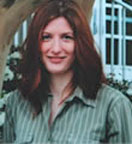So You Talk to Cows? A Look Inside Agricultural Communications
By: Aimee Malone

Aimee Malone
Well, I'm not exactly Dr. Doolittle, and I don't talk to plants. But I do talk to people. I talk to people about agriculture and science. That's what my degree in agricultural communications has trained me for.
The agricultural communications (AGCO) major is a unique blend of agriculture, biological science, physical science, communications, journalism and public relations. It was the diversity of these subjects that first interested me, and an aspect of my career that I still enjoy. As a student, I was consistently fascinated with my classes ranging from organismal biology to reporting to soil science to public relations. In a day, I could interview a World War II veteran for a news article and learn to pen sheep for shearing in an animal science lab.
In addition to the variety of activities, AGCO made possible the opportunity to meet and talk to many different people. During my internship with the CoAg Ag Communications and Marketing office, I came in contact with business and agricultural professionals, scientists, government officials, doctors, engineers and the general public. Writing an article on water quality led me to speak with an Environmental Protection Agency official, a researcher and an area resident where a water quality monitoring program had been introduced. My internship experience (a requirement of the AGCO curriculum) showed me what things I liked about my career choice and what things I didn't. It gave me an idea of what direction I wanted to go when I graduated and began looking for a job.
I preferred working with publications rather than in sales and related fields. I also knew I wanted something that offered a lot of variety. When the opportunity opened for me to stay and work with CoAg, I gladly signed on. I have a job that allows me to work where I'm most effective–multi-tasking. I often have four or five different projects on my schedule for the day.
Usually, I start my day checking my e-mail and any messages that might have been left on my desk. Then I take a look at what different jobs I have to work on (I keep an ongoing list), prioritize them and work from the first item on my list down. That could be an article for Ag Illustrated or a news release to edit, or I may need to make updates on the CoAg and AAES Web sites. I often have these ongoing jobs, plus a piece like this to write.
In the middle of these tasks, I answer phone calls. Someone might want information on installing an irrigation system or want to order a publication about turfgrass production. I've learned which professors in the different departments to refer people to. I also get requests to take photos from time to time. When this happens, I drop whatever I'm working on, and then I may run to take photos at the entomology lab or at an environmental education session for school-age children.
In addition, I always have several long-term projects to work on, as needed. One of these has been converting a long (200-page!) publication about beetles to Web pages and posting them on the Internet. I've learned far more than ever thought I would about the leaf beetles of Alabama.
Another job that's always in progress is organizing the AAES' publication archives. I keep a folder with a printed list of all the different types of publications that the AAES has produced over the years. Considering that the archives date back to the 1880s, maintaining these records is a sizeable task. I also have worked to get this list of publications online and accessible to the public, and am always thinking about ways to refine the publications Web site. (If you have any ideas about improving the site–contact me at malonaa@auburn.edu).
While this is by no means an exhaustive account of my duties, it illustrates a little of what agricultural communications involves. It's a diverse job that requires multi-tasking, and I have come to appreciate its many challenges. I enjoy gathering information about agriculture and science and using many different avenues to communicate it to others.
So, while agricultural communications has not given me any super power to talk to animals, it has taught me a lot about people and agriculture.
Malone is a 2002 graduate in ag communications who now works in CoAg's Communications and Marketing office.
